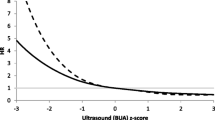Abstract:
Combined indices of ultrasound measurements have been proposed, such as “stiffness index” (SI) for the Lunar Achilles+ and ‘quantitative ultrasound index’ (QUI) for the Hologic Sahara ultrasound devices. We used the Bland and Altman approach and the kappa (k) score (classifying women by tertile, independent of age) to compare these methods. We studied 105 postmenopausal women (ages 57 to 88 years). We measured the heel (in duplicate) using both devices. Single lumbar spine (LS) bone mineral density (BMD) measurements were also made using the same two manufacturers’ densitometers. QUI values were higher than SI values with a mean difference of 2.4 units (95% CI, 1.5–3.2). This difference in SI and QUI was most marked at higher ultrasound values (r= 0.61, p<0.0001). The kappa score between SI and QUI was 0.69 (95% CI, 0.57–0.80). When we calculated the kappa scores based on the mean of duplicate SI and QUI measurements, the kappa score increased to 0.90 (95% CI, 0.77–0.94). Lunar DPX LS-BMD values were higher than Hologic QDR 1000/W LS-BMD values with a mean difference of 0.18 g/cm2 (95% CI, 0.17–0.19). The difference between the machines was most marked at higher BMD values (r= 0.38, p<0.001). The kappa score between the DPX and QDR 1000/W was good (k = 0.79, 95% CI = 0.66–0.88), and was similar to the agreement of SI and QUI. Based on a single measurement, some women would be classified in different tertiles using the two heel ultrasound machines (about 20%). However, this is not significantly greater than the misclassification rate using two machines to measure spinal BMD (about 15%). Although there are significant differences between SI and QUI measurements, the misclassification rates are similar to those observed measuring LS-BMD using two different manufacturers’ DXA machines. The misclassification rate using quantitative ultrasound improves when based on duplicate measurements.
Similar content being viewed by others
Author information
Authors and Affiliations
Additional information
Received: 6 October 2000 / Accepted: 22 February 2001
Rights and permissions
About this article
Cite this article
Ingle, B., Sherwood, K. & Eastell, R. Comparison of Two Methods for Measuring Ultrasound Properties of the Heel in Postmenopausal Women . Osteoporos Int 12, 500–505 (2001). https://doi.org/10.1007/s001980170096
Issue Date:
DOI: https://doi.org/10.1007/s001980170096




